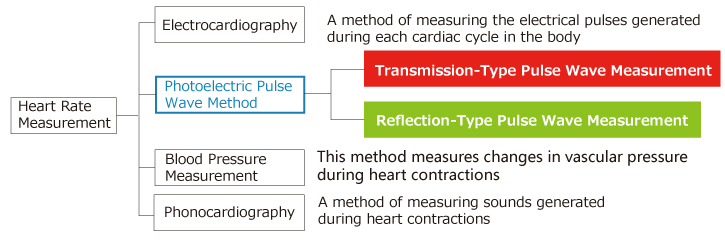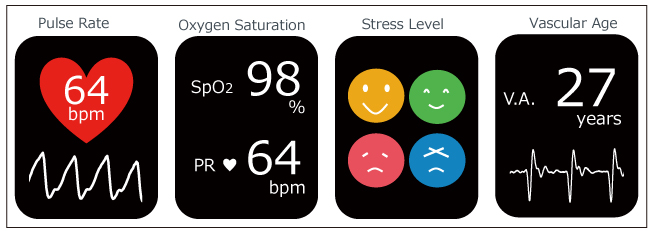<Pulse Sensor>
What is a Pulse sensor?
A pulse wave is the change in the volume of a blood vessel that occurs when the heart pumps blood, and a detector that monitors this volume change is called a pulse sensor.
First, there are four main ways to measure heart rate: electrocardiogram, photoelectric pulse wave, blood pressure measurement, and phonocardiography.
Pulse sensors use the photoelectric method.

Pulse sensors using the photoelectric pulse wave method are classified into 2 types depending on the measurement method: transmission and reflection.
Transmission types measure pulse waves by emitting red or infrared light from the body surface and detecting the change in blood flow during heart beats as a change in the amount of light transmitted through the body.
This method is limited to areas where light can easily penetrate, such as the fingertip or earlobe.
ROHM is currently developing a reflection-type pulse sensor (Optical Sensor for Heart Rate Monitor).
The reflection-type pulse sensor (Optical Sensor for Heart Rate Monitor) is explained below.
Reflection-Type Pulse Sensor (Optical Sensor for Heart Rate Monitor)
Reflection-type pulse sensors (Optical Sensors for Heart Rate Monitor) emit infrared, red, or green light (~550nm) towards the body and measure the amount of light reflected using a photodiode or phototransistor. Oxygenated hemoglobin present in the blood of the arteries has the characteristic of absorbing incident light, so by sensing the blood flow rate (change in blood vessel volume) that changes following heart contractions over time we are able to measure the pulse wave signal.
Also, since reflected light is measured, the range of suitable areas is not limited as with transmission-type pulse sensors.
Reflection-Type Pulse Sensor (Optical Sensor for Heart Rate Monitor) - Operating Mechanism

Pulse wave measurement using red or infrared light can be affected by infrared rays contained in sunlight (i.e. outdoors), preventing stable operation. For this reason, usage indoors or semi-indoors is recommended.
For pulse wave measurement outdoors (i.e. by smart watches), a green light source which has a high absorption rate in hemoglobin and less susceptibility to ambient light is preferred, so ROHM utilizes green LEDs as transmission light sources.
Pulse Sensor (Optical Sensor for Heart Rate Monitor) Applications
Generally, by looking at the period of fluctuation from the waveform obtained by measurements of the pulse wave sensor and observing the pulsation (variation) using the heart rate along with both red and infrared waves, it is possible to measure the arterial blood oxygen saturation (SpO2).
In addition, using data from pulse sensors is expected to enable calculation of various vital signs such as HRV analysis (stress level) and vascular age through high-speed sampling and high accuracy measurement.





